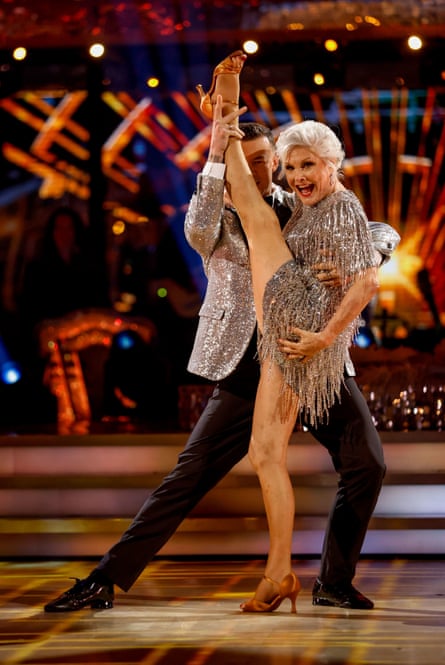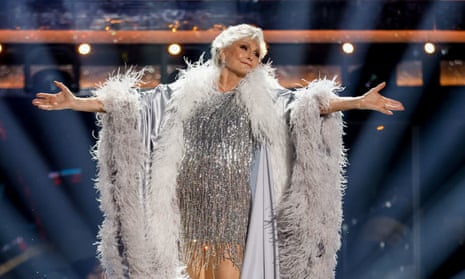Whether you can do the splits is a favoured test of flexibility in the playground, but it’s generally assumed that most people over 40 can’t. So when 78-year-old Angela Rippon kicked her leg into a standing split on Saturday’s Strictly Come Dancing, she caused a stir among viewers.
Rippon is the show’s oldest ever contestant, yet experts say her move is difficult for most younger people and highly unusual for someone her age, as the body stiffens with age, while balance and muscle strength decline.
Rippon has said she wanted to push age-related boundaries on the show: “I’ve told my pro partner, Kai [Widdrington], there are things I can do, and things I can’t. I just want to do everything properly. I’ve told him: ‘Challenge me.’”
In an interview with the Radio Times, she said she wished she had been asked on the show 10 years earlier as she is “not as fit or strong” as the younger contestants, though she has kept fit through tennis, pilates and ballet.
Rippon also wants to advocate the benefits of dance at all ages, which she learned about while making the programme How to Stay Young in 2016. “After six months, for everyone tested, dance came out head and shoulders above any other kind of exercise. It’s the perfect all-round mind and body exercise, and does the full social thing as well. So Strictly will be a way of putting my money where my mouth is.”
Dawn Skelton, professor of ageing and health at Glasgow Caledonian University, said that Rippon’s move is impressive because “from the age of 40 we start seeing obvious declines in our flexibility”, with women losing the natural flexibility designed to help the pelvis expand during childbirth as oestrogen declines during the menopause.

Genetics also dictate how flexible you are, as well as your speed and power, but everyone can become more flexible with practice at any age – though if you want to learn moves that really challenge your body, it’s better to start young, Skelton said.
“If you couldn’t do the splits at school, chances are you’re not going to be able to – even with best training package in the world – do it when you’re 60, 70, 80,” she said, adding that this is because there are changes in the muscles and tendons as we age, and fat infiltrates the connective tissue.
Flexibility is good for “lengthening the muscle and ligament so you can move a joint through its fullest range of motion” – and is a particularly important attribute for dancers, many of whom are hypermobile – but it is often ignored in fitness training programmes unless they include yoga or pilates, said Skelton.
To learn to do the splits, the key is to lengthen the hamstrings – the muscles down the back of the leg – which tighten considerably with age. Good core strength holds the body in position, as does hip mobility.
The important thing to remember, Skelton said, is that Rippon is now reaping the benefits of “a lifetime’s history of being active”.
She said: “Anything you find difficult, chances are if you practise more often you would be able to do it. If it’s embedded in your life like Angela, that’s what you can maintain. It’s a reminder that we don’t all have to become frail – because a lot of people are at Angela’s age. So if you’re in the 40s and you can still just about do a split then now’s the time to do loads more if you want to maintain that skill.”
after newsletter promotion
The splits are considered a “very advanced dance move at any age”, said Sarah Riach, the associate head of school for performance at the University of Sunderland. Watching the show, she was “impressed by [Rippon’s] cha-cha-cha, and the standing split came as quite a surprise”.
Riach said there are several different types of splits, including the standing split performed by Rippon, and the box split, where the dancer faces forward with their legs out to the side. Different people will find some easier than others, and some dancers can only do a standing split on one, more flexible leg.
Sadie Hunt, a senior dance lecturer at the University of Bedfordshire, said people who have naturally long hamstrings and hip joints with a wide range of motion will find a standing split easier than most, while some people may never be able to do it.
She recommended that people use breathing and imagery to extend stretches rather than forcing their body into positions, which can cause damage. The most effective moves, she said, would be anything that lengthens the hamstrings, and releases the hip joints – lunges, hamstring stretches – but go gently and know it takes time”.
She added that Rippon’s dance echoed her favourite attributes of Strictly: “The hard work and sheer joy of dancing, and that it is for everyone.”








